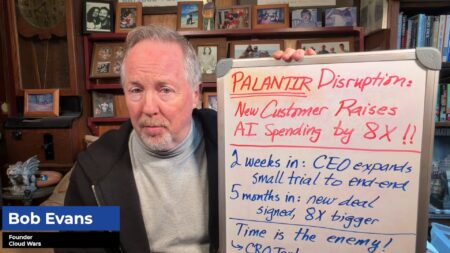
As the battleground in one of the tech industry’s longest-running and most intense rivalries has moved inexorably to the cloud, has 50-year-old SAP or 45-year-old Oracle pulled ahead in this enormously strategic and lucrative market?
It’s a battle being contested on multiple fronts and impacting hundreds of thousands of business customers evaluating whether Oracle or SAP is the better choice to take those businesses into the digital future.
Before making the case for each company, I’d like to point out what I believe is the most critical issue: SAP has about 25,000 on-premises ERP customers that will, within the next couple of years, begin their moves to the cloud or accelerate ongoing pilots.
So, the questions are simple: Can SAP keep the vast majority of those 25,000 customers by showing that it has morphed into a superbly capable cloud provider?
Or, will Oracle be able to live up to the challenges, taunts, and promises made frequently by founder and chairman Larry Ellison about how Oracle will be able to snatch huge chunks of SAP’s massive installed base of on-premises customers?
Also, to give you a sense of what each company’s been up to lately, at the bottom of this article, I’ve included extensive lists of my latest Cloud Wars analytical coverage of SAP and of Oracle.
But for now, here are the cases for why each company can claim to be ahead of the other in the battle for leadership in cloud enterprise applications.
SAP: Why It Can Claim to Be Ahead of Oracle
1. Cloud-revenue growth rate of 34% for Q2.
True, in constant currency, the cloud-revenue growth number was 24%, but there’s no question that SAP’s cloud growth is accelerating, and is doing so across the board. That 34% figure means that SAP’s cloud business — which is now larger than its on-prem business — is growing faster than the cloud revenue of every single Cloud Wars Top 10 company, with the exception of Google Cloud (36%). You can get more details on that in The Most Important Numbers in SAP’s Q2 Blowout.
2. Those 25,000 on-premises customers are SAP’s to lose.
For all of Ellison’s proclamations to being on the verge of carving out vast swaths of SAP’s on-prem ERP base, SAP has gone on offense with a number of new initiatives to ensure that those big customers not only agree to go to the cloud with SAP but that they are in fact delighted to do so.
3. The “RISE with SAP” has been a huge success.
CEO Christian Klein regularly highlights RISE as an entirely new type of consumption model that allows customers to re-imagine and plan out their business futures first, and then work with SAP to map out the resulting optimal tech roadmap. You can see more about that in my interview with SAP President of Cloud, Brian Duffy: SAP’s Game-Changing RISE Program is a Journey, Not a Destination | Cloud President Brian Duffy.
4. SAP has unified its acquired apps and data flows with Business Technology Platform.
A few years back, SAP’s cloud transformation was slowed by the mismatched architectures of its SaaS portfolio of applications, which stunted the customers’ ability to gain the full benefit of unified data flows across those apps. SAP’s Business Technology Platform has now harmonized all that and also gives SAP customers a highly flexible bridge across the cloud and on-premises apps and workloads.
5. SAP’s S/4HANA Cloud is growing more rapidly than Oracle’s Fusion ERP.
For Q2 ended June 30, SAP said its S/4HANA Cloud revenue grew 84%, or 72% in constant currency, which is well ahead of the growth rates Oracle has offered over the past few quarters for its Fusion ERP. I believe Fusion ERP revenue is still significantly larger than that for S/4HANA Cloud, but Oracle has the jump on number of customers deploying its cloud ERP product by a wide margin.
Oracle: Why It Can Claim to Be Ahead of SAP
1. Fusion ERP jumped out to a big head start over S/4HANA Cloud.
About a year ago, Ellison proclaimed that Oracle’s cloud ERP market share would probably be 90% or more, but that’s no longer the case, as the SAP offering is growing at a blistering pace. But Oracle and Ellison continue to put enormous effort behind its Fusion ERP application and will be relentless in continuing to showcase that it has more customers and market share than S/4HANA Cloud.
2. Oracle is making Fusion ERP the centerpiece for new cloud-based offerings.
Ellison has spoken about co-creating with customers and partners on a large portfolio of B2B cloud services orbiting a Fusion ERP hub. I believe Oracle has been more aggressive in positioning Fusion ERP as an indispensable piece of its fast-growing industry cloud business as well.
3. Oracle Cloud Infrastructure.
Including not only compute and network infrastructure but also the Autonomous Database and other cloud-database services, OCI gives Oracle a fast-growing foothold in a part of the cloud market that SAP does not serve.
4. Oracle has been more aggressive with industry cloud buildouts, highlighted by Cerner.
As I’ve said many times over the past year, I believe that industry clouds will rapidly become the hottest segment within the enterprise cloud, which, after all, is the greatest growth market the world has ever known. In the past few months, Oracle has begun aggressively fusing its industry strategy with its overall strategy, giving it a leg up in what will be an enormous market. For more on this strategically vital category, please see Industry Cloud Top Ten: Oracle Jumps to No. 2.
5. Oracle expects fiscal Q1 cloud revenue to grow at least 44%.
In mid-June, CEO Safra Catz said fiscal Q1 cloud revenue for the 3 months ending August 31 will be between 44%-47%, an achievement that would catapault Oracle to being the world’s fastest-growing major cloud provider — by far. I expect that Oracle will release those quarterly results around September 13, when we’ll discover if it, boosted by the inclusion of Cerner revenue, has jumped into the hypergrowth category. For more on this, please see Oracle to Become World’s Fastest-Growing Major Cloud Provider With Cerner.
Final Thoughts
Reprising a line I’ve used many times, the biggest winners in the Oracle versus SAP competition are business customers who will be the beneficiaries of enormous innovation, value, speed, customer care, and co-innovation as these two storied companies put everything they have into dazzling those customers and beating their rival.
In a few weeks, when the Oracle numbers come out, we’ll update this extraordinarily competitive battle in the Cloud Wars. Meanwhile, I hope you find the resources below to be of value.
My recent coverage of these two terrific companies:
SAP
- SAP Q2 Cloud Surge: Outgrowing Microsoft, Salesforce, and ServiceNow
- Video: Who Are the Hottest Q2 Cloud Vendors?
- Video: The Most Important Numbers in SAP’s Q2 Blowout
- Podcast: SAP’s Game-Changing RISE Program is a Journey, Not a Destination | Cloud President Brian Duffy
- Podcast: SAP Fioneer Is Redefining What a Financial Services Vendor Can Do | Falk Rieker & Mitch Bouchard
- In the Cloud, Legacy’s Revenge: Oracle, SAP, IBM Thrive in Hot New Category
- Video: SAP’s Julia White Shares the Unlearning Journey From On-Premises to the Cloud
- Podcast: Driving Supply Chain Mastery | Thomas Saueressig of SAP on Business Transformation
Oracle
- Oracle to Become World’s Fastest-Growing Major Cloud Provider With Cerner
- Larry Ellison’s Healthcare Transformation: Oracle Makes Biggest Bet Ever
- Video: Oracle Gives AWS the Boot, Will Infuse Cerner With Its Own Tech
- Video: Industry Cloud Top Ten: Oracle Jumps to No. 2
- Larry Ellison on Healthcare Revolution: a Sneak Peek at Oracle’s Plans
- Video: Oracle Healthcare: “A Moral Obligation”
- Video: Larry Ellison on Multicloud Boom: “Customers Love Choice”
- Larry Ellison and Satya Nadella Create the Multi-Cloud Future
- Video: Microsoft, Not Oracle, Is the New #1 in the Data Center Wars
- Multi-Cloud Magic: How Oracle-Microsoft Cloudmance Dazzles Customers
- Video: Why Google Cloud, Microsoft, and Oracle Q2 Achievements Merit Special Attention
- Podcast: How Oracle is Helping Telco & Banking Clients Answer Change with Innovation | EVP Jonathan Tikochinsky








